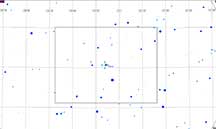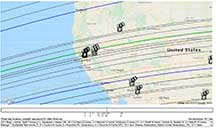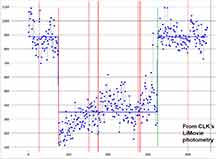The Occultation of a 13.4 star by the Uranus Moon Umbriel
Mon Sept 21 at 1:27:06 am PDT
This event is primarily valuable for improving the orbital ephemeris of Uranus itself, and it's moon system. Valuable then for future space missions to the outer solar system. We have not sent a space craft to Uranus since 1986 and Voyager. The 13.4 star is bright enough that with integration in a clear sky, it should be do-able with a 8" SCT equipped with a Watech 910hx camera as some of us use. The duration is 68 seconds, long enough that using an integration of 16x or even 32x (1/2 second) will still be valuable. Umbiel is going to be 15" from the center of Uranus, or about 13.5" arcsec from the limb of Uranus, that's a little less than half the separation for Albireo, and should be easily split in this scope. Perhaps take out the f/3.3 focal reducer, although this will lower the concentration of the star image onto fewer pixels.
This map shows the layout. However the verbal description of the path seems to differ from the path shown on the map. Here in Santa Cruz, we appear on the map to be well inside the path, but the verbal description says the path edge goes from "Northern California to central British Columbia" suggesting we are on the southern limit.
This source says that Umbriel is at magnitude 15.0. But Wikipedia says at opposition its v=14.5. For the event, which is not quite at opposition, 14.6 should be about right. The target star is listed at V=13.5. The combined magnitude is therefore V=13.16. I'd recommend California observers recording from 1:23:30am to 1:31:30am
The Numbers...
V mag drop: from 13.16 to 14.6
Altitude at event from Santa Cruz: 54 degrees up in the East, in Aries.
For the Celestron 8SE; press the "Planet" button on the hand paddle and click on Uranus. No need to enter RA and Dec.
Image scale with the f/3.3 focal reducer 1530 arc sec/768 pixels or 2.0 arcsec/pixel horizontal. That means the target is only 7 pixels away from Uranus. We can get more pixels by getting rid of the f/3.3, giving about 20 pixels but blurrier focus. The f/6.3 will give 13 pixels away from the limb of Uranus, but with seeing and blooming, it'll look less.

Q70 eyepiece view |

Watec 910hx LCD chip view |

Extreme close up, showing the target should be due left of Uranus for our alt/az 8SE scopes. |

Preston prediction map. We appear to be near the center line, but with significant uncertainty. Nominal odds of a "hit" are 32%. |

Stations from OW. Non-OW RIO feed observers (like me, Kirk, Chris K...) are not shown. |
Results:
Success! Both Kirk and I got good data, and the predicted path seemed to be spot on. Chris Kitting too got good data, but is having a problem getting his recording to .avi format on a Win10 machine for analysis. But it's in process. I observed from the gate at the Upper Campus of UCSC on the campus side.
Nolthenius Observations:
I had trouble getting LiMovie to not snap to Uranus from the faint star only 13 arc sec away. In the end, Tony George reduced my .avi file after I uploaded it to DropBox, using PyMOVIE. It's his reductions I reported on 9/20/20. I now realize that to position a measuring aperature and NOT have it snap, I need to do two things... put Star Tracking to "off", and also when I right-click to place the circle, use "Set Position Only". That would solve my problem. However, Tony's work is so good, I'll not bother for now trying to re-do in LiMovie.
The csv file output by PyMovie from Tony. This is his "tg3" version, his last and favorite: PyMovie-RN.csv
This is the log file produced. PyMov-RN-log
"More fiddling with results. I did a ‘better’ PyMovie run, with a 91-pixel aperture and 3.3-pixel default mask for the static aperture. This resulted in perfect tracking during the mid-event slew. Here are the comparison results:
Analysis Method |
SNR |
Mag
Drop |
Dur |
D Error
95% |
Limovie |
4.80 |
1.00 |
66.1889 |
0.2696 |
Limovie2 |
6.22 |
1.05 |
65.9864 |
0.1913 |
PyMovie |
6.40 |
1.66 |
65.8852 |
0.2226 |
PyMovie2 |
6.76 |
1.22 |
65.9605 |
0.1633 |
PyMovie3 |
6.77 |
1.19 |
65.9597 |
0.1641 |
PyMovie is better than the corresponding Limovie results. Note the highlighted cell where previously I inadvertently inserted the 1-sigma error bar instead of the 0.95% confidence 2-sigma result. My .log and .csv files are attached. The difference in PyMovie2 and PyMovie3 is the use of lunar limb background in PyMovie3. With a 91-pixel aperture, the method of background subtraction is insignificant. Also note that a new version of PyMovie now inserts all the settings used in PyMovie into the .csv file so others can copy or improve on results. FYI. I cc’d Bob Anderson on this one message so he can see the progression of results and also the confirmation of his recent change to PyMovie."

I set up next to the East side gate at the upper meadow of UCSC where the bike trail crosses. Conditions were perfect. No wind, good seeing. |

This is from Tony's 2nd go through. The bad point in the middle of the event was from the slew. That was fixed with his re-adjustment of aperture. But he didn't include the light curve for that. |

My LiMovie screen (not fully configured in the parameter boxes as I would do it), just to get a screen capture of the video view. |

From my Watec displayed in LiMovie, zoomed in. |
|
Kirk Bender's Observations:
Kirk set up across from the fire station at Empire Grade and Felton-Empire Rd. He used the Watec 910hx I gave him. (It turns out that the Watec 910hx models before serial number 1000 are significantly less sensitive than later models. That explains why I consistently see on the same event that his data is better than mine. My model number is 623. I'll now work to recover the newer Watec 910hx from Cabrillo, with RC unit, and begin using that.)
Kirk generated LiMovie results easier than I. He used no focal reducer while I used the f/6.3 reducer. In hindsight, I should have tried none, but I had recalled an earlier experience of forgetting to put on the f/3.3 and had no FR at all, and could not reach focus. Apparently I'm mis-remembering. I used Kirk's LiMovie .csv file to generate results I'll post below. As I write this Ted Swift is attempting to use PyMovie on it to get perhaps some improvements. We'll see. As of 9/27 I have not filed his report to IOTA yet.
Chris Kitting's Observations:
Chris had a good success with his 10" Newt and Watec 910hx. Some adventures in getting it read properly, but Ted Swift came through with a good PyMovie analysis, which is what I am reporting. Chris sent this earlier; the timings however are better determined on the PyMovie analysis. The step events referred to below were due to the occultation happening during integration.
10" Newtonian on decent GEM, at prime focus (1200mm f)
Watec 910HX at 16x shutter (=1/4 sec) or 8 frames per integration
N 37.64690
W 122.03586 Elevation 620 ft. (SE Hayward, CA)
By eyeing the video:
Dimming began at 8:26:30.1110 (half out at 8:26:30.38)
Dim Umbriel, while occulting the star, appeared to slightly brighten briefly at 8:26:54.5

This is PyOTE's light curve of the integrations points (each point here is 8 frames), from Chris' LiMovie CSV file analyzed by me. Ted's PyMovie analysis is likely more reliable and is what was submitted to IOTA on 10/1/20. |
|
|
|
|
The PyMovie + PyOTE analysis of Chris' original video.avi showed Chris had a 66.33 second occultation. S/N was 2.88.
Kitting's PyMovie photometry .csv file
Kitting's PyOTE
Follow-Up
A new paper is ready for submission to MNRAS - Assafin et al. 2023 which analyzes our data for this event. The paper's not published and so not ready for linking here, but the front page gets the main ideas across...












